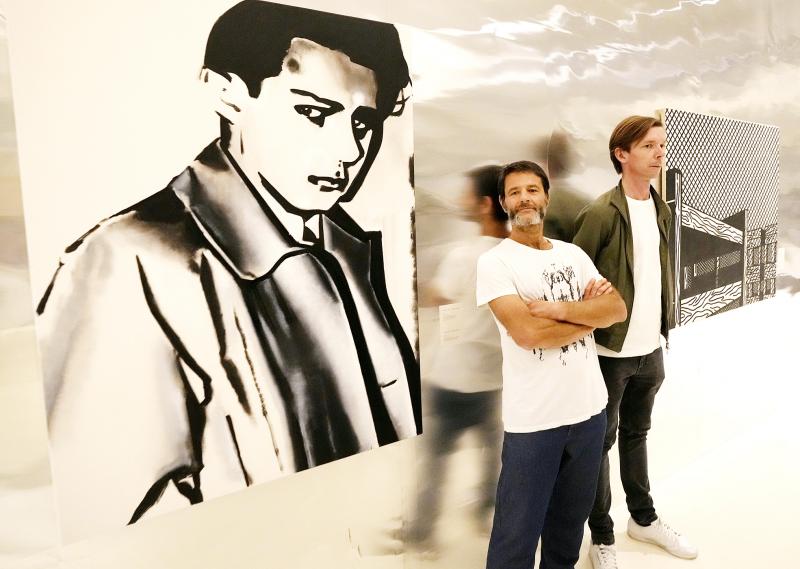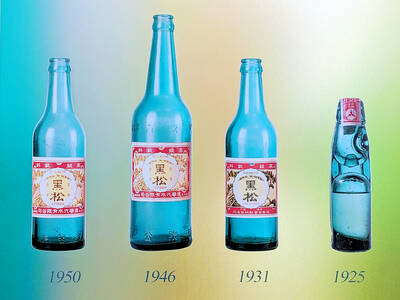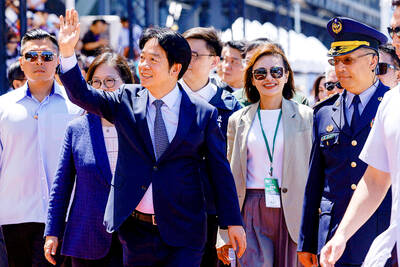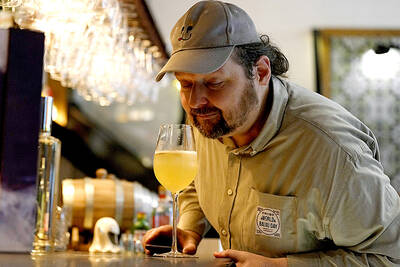Warsaw’s Jewish history museum opened an exhibition Thursday featuring works by a renowned Polish artist that confront the lingering and melancholy presence of the Holocaust in Poland, where Nazi German forces carried out their destruction of Europe’s Jews and other atrocities.
“Wilhem Sasnal: Such a Landscape” opened Thursday at the POLIN Museum of the History of Polish Jews. The dozens of paintings and drawings on display confront the Holocaust in the nation’s physical and mental landscape and the difficulty in addressing an unsettled past.
Sasnal, who is not Jewish, has for two decades been grappling with this history. The 48-year-old described a generational need to confront the past, also because parts of Polish society refuse to acknowledge that while Poland was victimized by Nazi Germany, there were also some Poles who joined in the despoliation and murder of the nation’s Jews.

Photo: AP
For decades after World War II, such discussions were taboo, with the themes of Polish sacrifice and honor dominating historical memory. But with the new openness that came with the fall of communism in 1989, scholars and artists began studying and speaking openly of anti-Semitism and the participation by some Poles in the German crimes. Each new book or film has touched a raw nerve.
“The history of the Second World War was obscured until 1989,” Sasnal said.
It was then “extremely shocking,” he said, when scholars began to reveal wartime wrongdoing by Poles, including the 1941 killing of hundreds of Jews by Poles in the town of Jedwabne.

Photo: AP
“At the beginning I felt anger and shame,” he said. “And it’s still so difficult to see that people don’t want to acknowledge it. People totally refuse, and this is the mainstream Polish government attitude.”
Sasnal is one of Poland’s most prominent living artists. His works are included in collections at the Museum of Modern Art and Solomon R Guggenheim Museum in New York, the Tate Modern in London and Centre Pompidou in Paris, among others.
Sasnal also acknowledged that Poland is often unfairly judged — that sometimes those outside of Poland lose sight of the bigger picture.
Poland was occupied by German forces who killed millions of Polish citizens — some two million Christian Poles as well as three million Jews. Many Poles fought the Germans at home and abroad and the state never collaborated with Nazi Germany. Thousands of Poles have also been recognized by Yad Vashem for risking their own lives to save Jews.
Yet Sasnal believes that Poles must acknowledge the bad along with the good.
“Unless we accept such a complex past, we will be judged and we will be misjudged,” he said.
The exhibition comprises two decades of works that touch in some way on the Holocaust — works that Sasnal did while also dealing with other topics.
The oldest ones were inspired by cartoonist Art Spiegelman’s Holocaust cartoon stories in his Maus books. The newest ones were created this year especially for the exhibition.
There are paintings of former death camps, but they are always contextualized, with Sasnal’s bike or his wife looking from inside a car at the gates of Auschwitz — because to depict the death camps alone would be too banal and brutal, he said.
The Auschwitz paintings were produced after he and his wife passed by the memorial site on their way home from a New Year’s Eve party on Jan. 1. Millions travel to the site from around the world. But for many Poles — including Sasnal, who lives in nearby Krakow — the presence of genocide memorial sites are part of the landscape of daily life.
A painting of an imagined map of Poland bordering Israel recalls the long co-existence of Jews with Poles in Poland, a Jewish homeland for centuries.
A portrait of Hitler has been covered in black paint and crossed out with a wooden bar, an evil too extreme to depict figuratively.
Paintings that draw on images first created by French painter Edgar Degas, an antisemite, are reminders of the antisemitism pervasive across Europe that created fertile soil for the Holocaust. One evokes a bathing women modeled on a Degas work superimposed with a swastika. Paintings of Gypsies or stereotypical images of Africans in the popular imagination show how other groups, along with Jews, have long been considered the “other” in society.
Ahead of the opening, the curator, Adam Szymczyk, braced for the possibility that this exhibition, too, might spark anger from nationalists and right-wingers.
But now that a right-wing party runs the country — and is a co-partner in the museum, which is a public-private partnership — he said he expected the reaction to be more muted.
He said both he and Sasnal were driven by a need to express remorse.
“I think this is our way of saying sorry on behalf of others,” he said. “The others don’t say ‘I’m sorry’ so we have to. It’s a duty.”

The unexpected collapse of the recall campaigns is being viewed through many lenses, most of them skewed and self-absorbed. The international media unsurprisingly focuses on what they perceive as the message that Taiwanese voters were sending in the failure of the mass recall, especially to China, the US and to friendly Western nations. This made some sense prior to early last month. One of the main arguments used by recall campaigners for recalling Chinese Nationalist Party (KMT) lawmakers was that they were too pro-China, and by extension not to be trusted with defending the nation. Also by extension, that argument could be

Aug. 4 to Aug. 10 When Coca-Cola finally pushed its way into Taiwan’s market in 1968, it allegedly vowed to wipe out its major domestic rival Hey Song within five years. But Hey Song, which began as a manual operation in a family cow shed in 1925, had proven its resilience, surviving numerous setbacks — including the loss of autonomy and nearly all its assets due to the Japanese colonial government’s wartime economic policy. By the 1960s, Hey Song had risen to the top of Taiwan’s beverage industry. This success was driven not only by president Chang Wen-chi’s

Last week, on the heels of the recall election that turned out so badly for Taiwan, came the news that US President Donald Trump had blocked the transit of President William Lai (賴清德) through the US on his way to Latin America. A few days later the international media reported that in June a scheduled visit by Minister of National Defense Wellington Koo (顧立雄) for high level meetings was canceled by the US after China’s President Xi Jinping (習近平) asked Trump to curb US engagement with Taiwan during a June phone call. The cancellation of Lai’s transit was a gaudy

The centuries-old fiery Chinese spirit baijiu (白酒), long associated with business dinners, is being reshaped to appeal to younger generations as its makers adapt to changing times. Mostly distilled from sorghum, the clear but pungent liquor contains as much as 60 percent alcohol. It’s the usual choice for toasts of gan bei (乾杯), the Chinese expression for bottoms up, and raucous drinking games. “If you like to drink spirits and you’ve never had baijiu, it’s kind of like eating noodles but you’ve never had spaghetti,” said Jim Boyce, a Canadian writer and wine expert who founded World Baijiu Day a decade